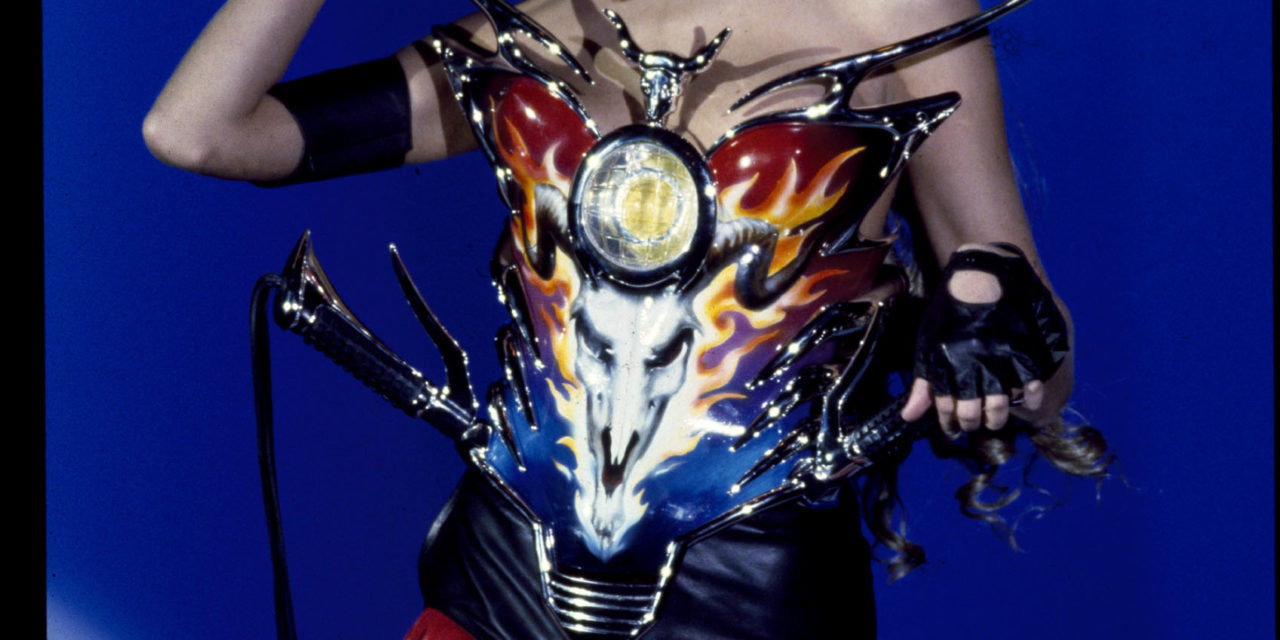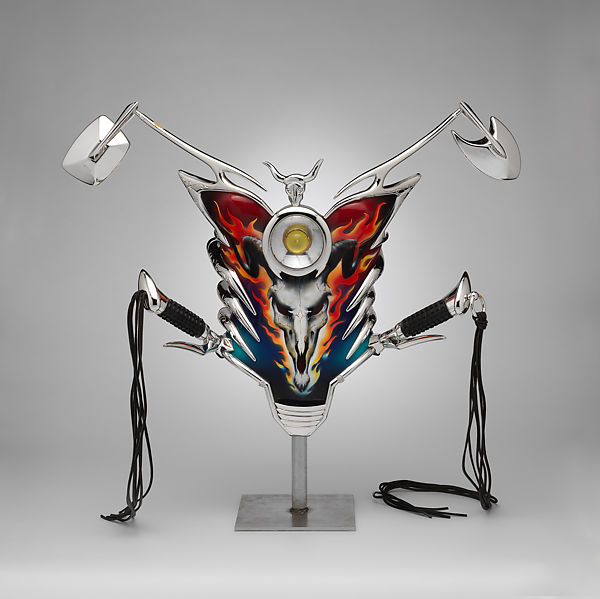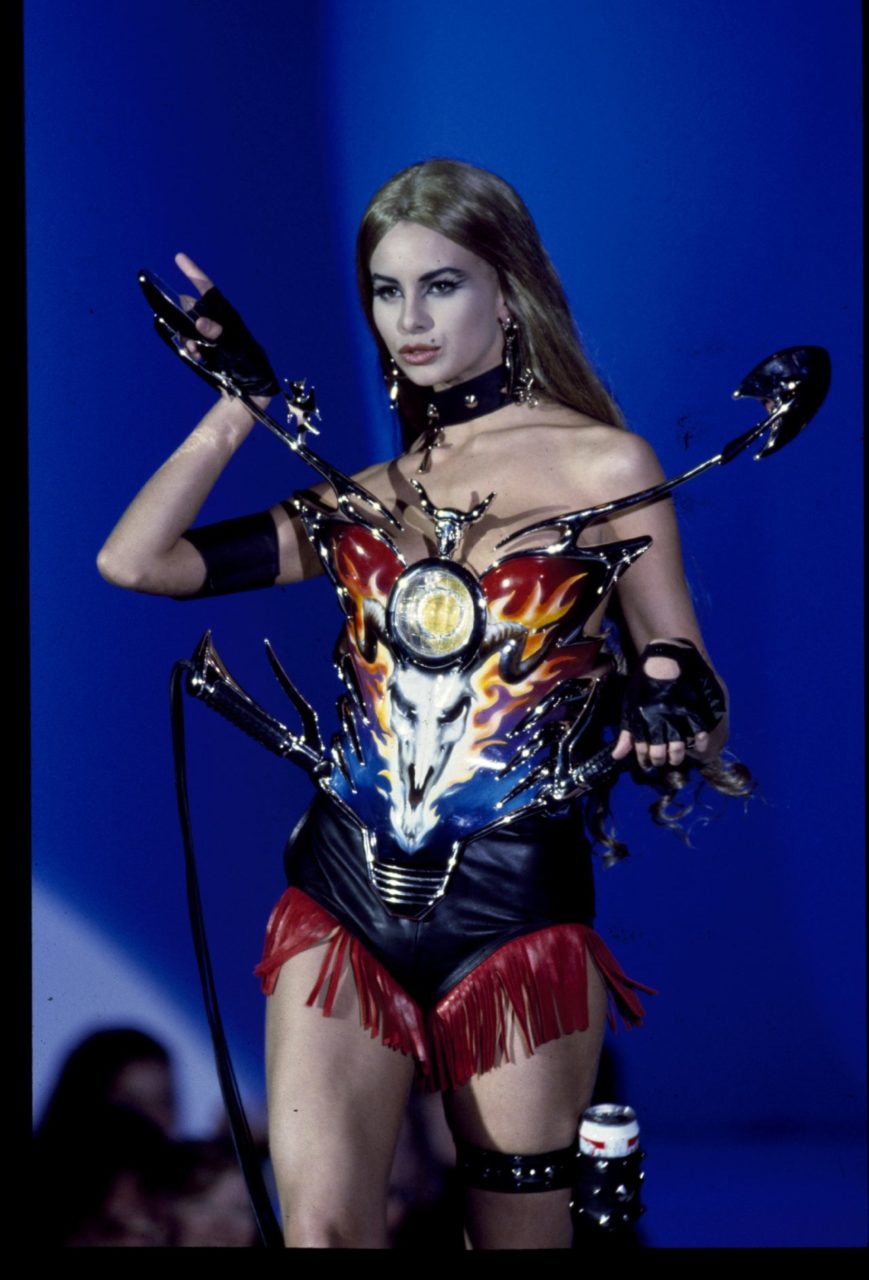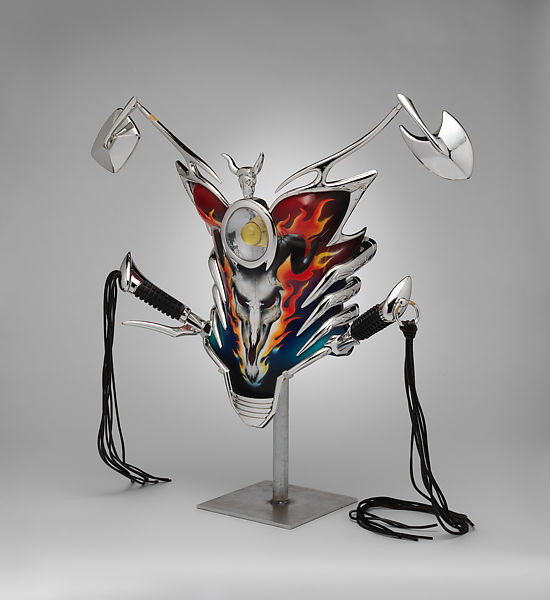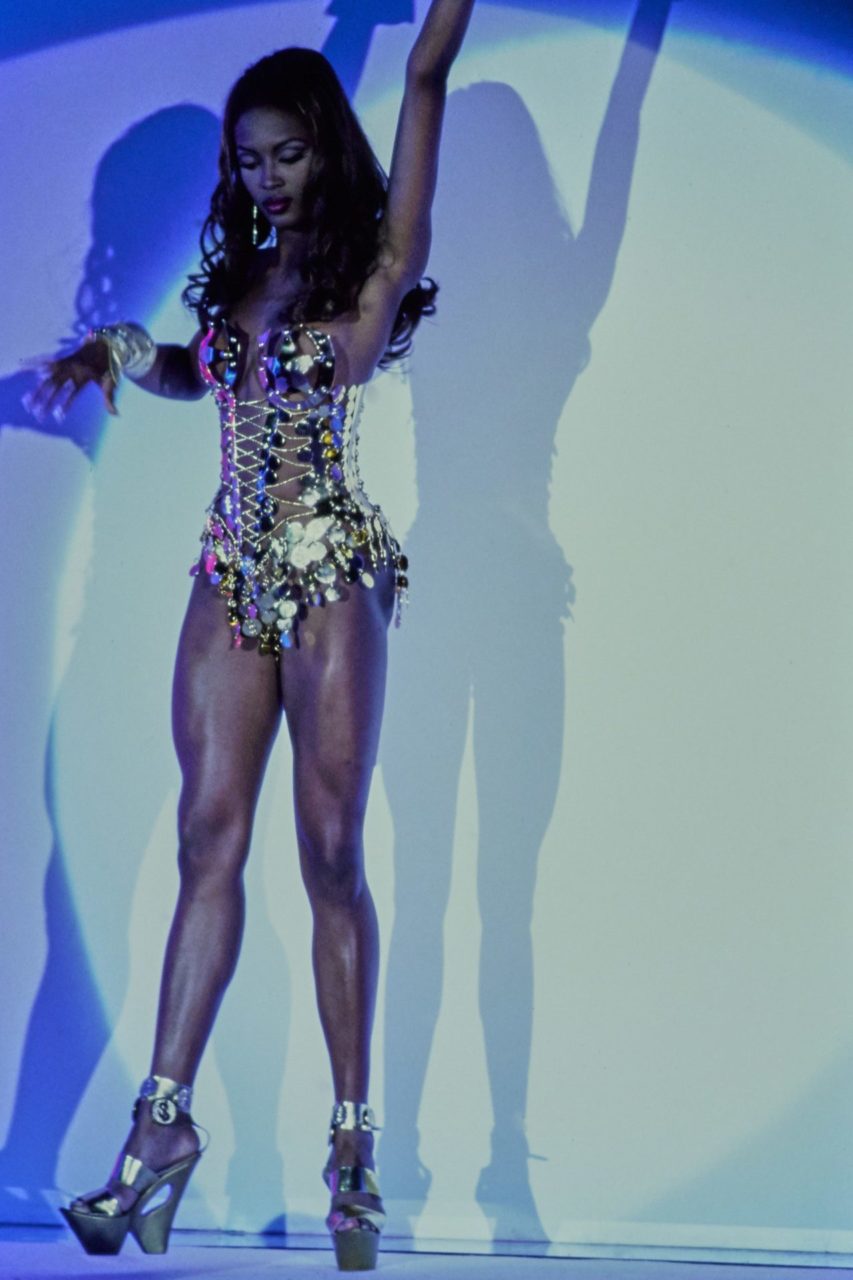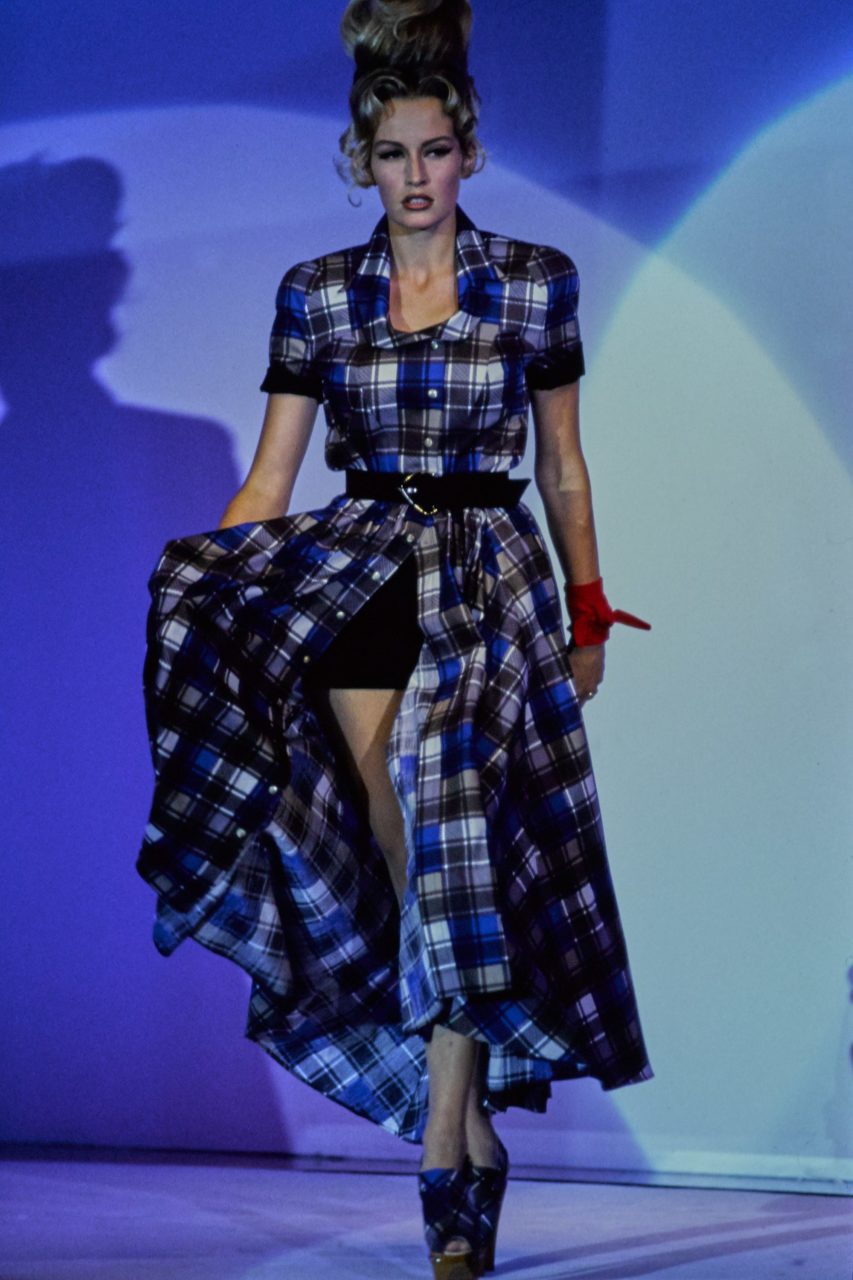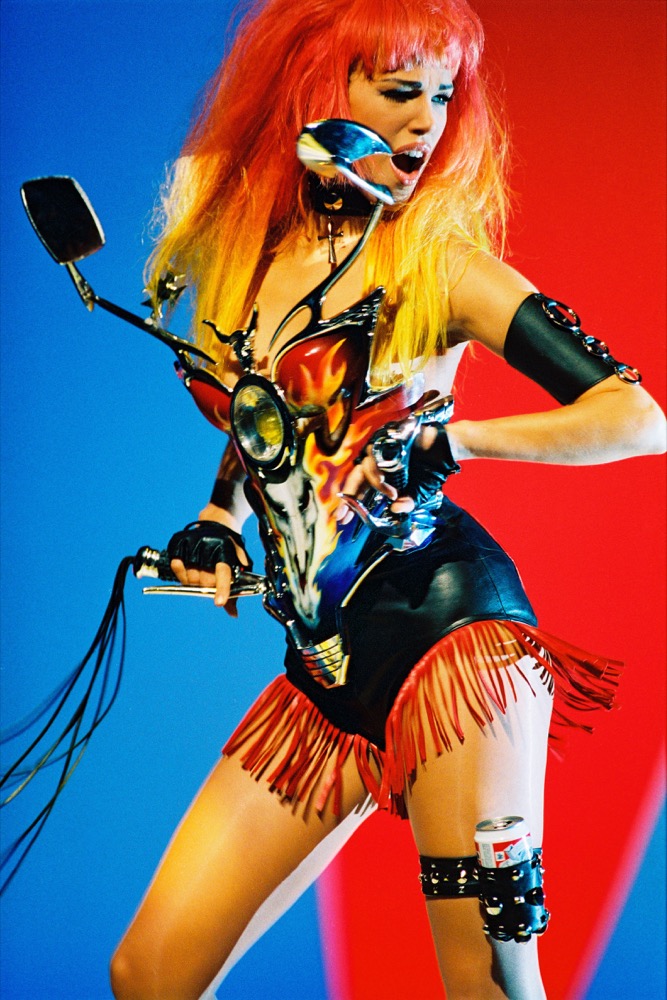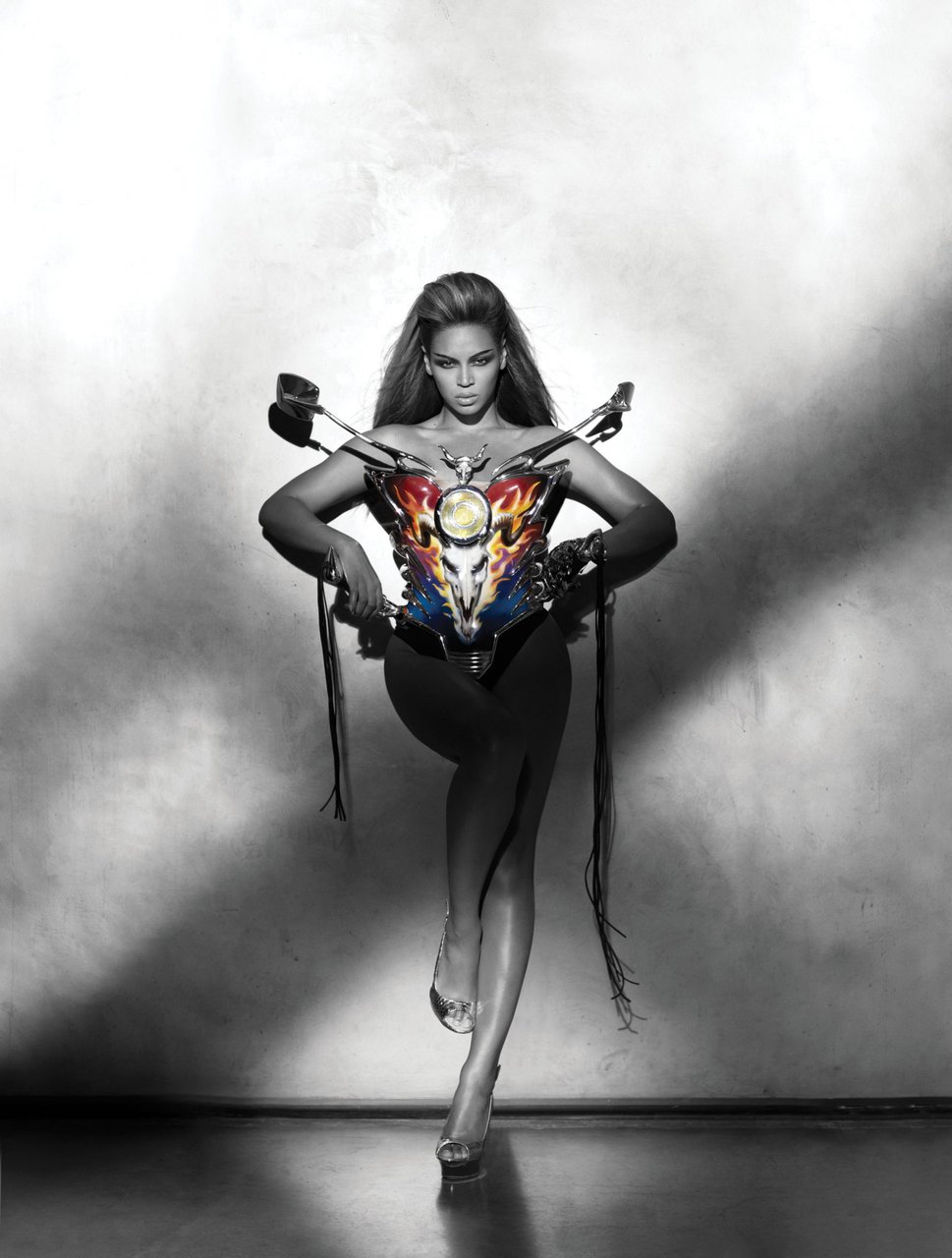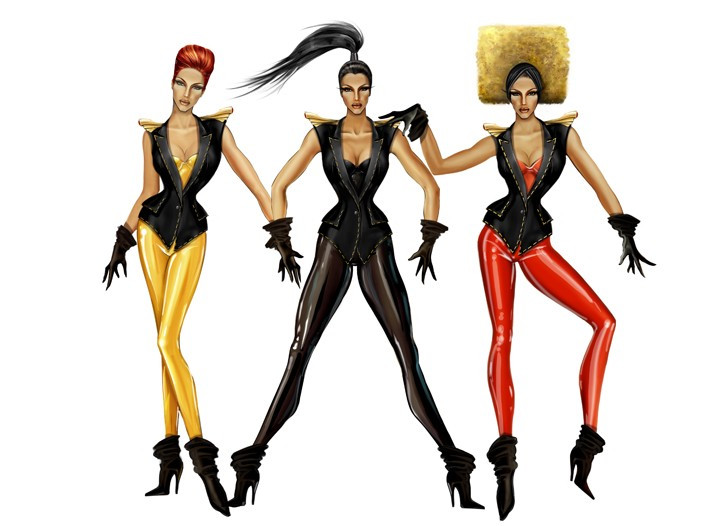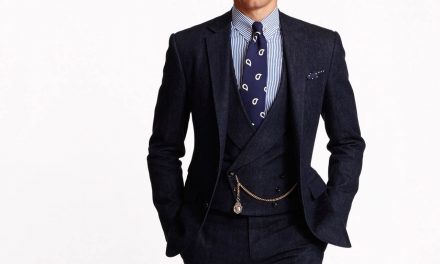This dramatic motorcycle-inspired bustier from Mugler’s spring 1992 show was fashionable, if not wearable, and has since been celebrated for its fierce theatricality.
About the Look
Thierry Mugler’s Les Cowboys Spring 1992 collection is one of his most impressive. This motorcycle-inspired bustier (Fig. 1) is a quintessential example of his work in this collection.
This striking bustier is comprised primarily of plastic, metal, and Plexiglas. The back has leather belts and metal buckles designed to wrap around the model’s body in order to keep the bustier secure (Fig. 2). The front features a graphic flame design in red, orange, and blue. The motorcycle inspiration is apparent in the shiny silver plastic outlining the graphic in the center, the black leather tassels dangling from the motorcycle ‘handlebars’, and the prominent rear-view mirrors extending past the wearer’s shoulders. In the center is an image of ram’s skull from above, conveying the edgy biker chic vibe that Mugler was aiming to achieve. Additionally, there is an unlit yellow light bulb in the top center front representing the headlight of the deconstructed motorcycle. While wearing this, the wearer is transformed into an edgy machine. The piece is seen on Niki Taylor on Mugler’s spring 1992 fashion show, paired with red-fringed black hotpants and black leather accessories (Fig. 3).
The bustier was purchased by the Metropolitan Museum of Art in 2001. The museum describes Mugler’s design on the object page:
“The citing of motorcycle imagery for a bustier melds the concepts of chassis and the female torso. The implication of the body as a vehicle to be driven or ridden inevitably raises the possibility of sexist interpretation. On the runway, however, the model, gripping her handlebar panniers, steered herself.” (Met)
In his exhibition catalog Superheroes: Fashion and Fantasy (2008), Andrew Bolton lines this Mugler piece up alongside designers like John Galliano, Alexander McQueen, and Walter van Beirendonck and discusses their most dramatic works:
“Adorned with skulls, hellfire, and other symbols of mortality, they embody both the multifocal eclecticism and semiological complexity that characterize the Postmodern body of both fiction and fashion and the darker terrors of our contemporary world.” (143)
Fig. 1 - Thierry Mugler (French, 1948-present). Bustier, Spring 1992. Plastic. New York: Metropolitan Museum of Art, 2001.252. Source: MMA
Fig. 2 - Thierry Mugler (French, 1948). Bustier, Spring 1992. Plastic. New York: Metropolitan Museum of Art, 2001.252. Source: MMA
Fig. 3 - Thierry Mugler (French, 1948-present). Motorcycle Ensemble, Spring 1992. Source: FIDM Museum
Thierry Mugler (French, 1948-present). Bustier, 1992. Plastic. New York: Metropolitan Museum of Art, 2001.252. Purchase, Richard Martin Bequest, 2001. Source: Metropolitan Museum of Art
About the context
Thierry Mugler always stuck to dramatic inspiration and flair when designing clothing. Mugler is known in the fashion world as producing extravagant fashion shows in which to exhibit his costume-like designs. In The History of Modern Fashion (2015), Daniel James Cole and Nancy Deihl introduce Mugler:
“Thierry Mugler had training in dance and experience in the corps de ballet of a regional company, a focus that informed his theatrical, body-conscious fashions… His aesthetic was dramatic at times, even campy.” (356)
Mugler’s camp aesthetic can also be seen in a similar metallic ensemble worn by model Naomi Campbell for the spring 1992 show (Fig. 4). Mugler was constantly inspired by the brilliant and dramatic world that he lived in. A motorcycle rider himself, Mugler found real inspiration in the rough biker aesthetic. An article for Women’s Wear Daily (1992) by Amy Spindler explained that Mugler did not suddenly find biker chic in the nineties: “Thierry Mugler designed his first couture outfit almost a decade ago: a black suit with metallic Cadillac ornaments, to look like a car or a motorcycle” (4).
The 1992 motorcycle bustier perfectly exemplifies Mugler’s campy and extravagant aesthetic. This piece featured everything Mugler was known for: creative silhouettes, vibrant colors, campy inspiration, and theatricality (Fig. 5). The bustier alone is a work of art, but when styled by Mugler, the entire ensemble came alive. Multiple publications reviewed Mugler’s spring 1992 show Les Cowboys. In Women’s Wear Daily (1992), Spindler describes the environment of Les Cowboys:
“In his usual theatrical style, Mugler filled the runway with saucy saloon girls, takeoffs of Miss Kitty and Mae West, Las Vegas showgirls, flashy L.A cowgirls and a few Harley Davidson toughs. Theatrics aside, Mugler did manage to get a firm grip on the season’s trends: fringe skirts, a herd of cowpoke chaps, calfskin prints, long shirtdresses, transparent looks, bi-level lengths, bare midriffs and even some bare bottoms.” (4)
Mugler not only stayed true to his aesthetic, but also showcased the prominent trends of the spring 1992 fashions. A shirtdress ensemble (Fig. 6) from the same runway is an example of this, featuring bold plaid, a strong black leather belt, and dramatic heels and hotpants. As a comparison, an Azzedine Alaïa ensemble (Fig. 7) from the same season shows a pale shirtdress and leather obi-style belt to bring in the waist, a more minimalistic version of the corsets and bustiers that Mugler indulged in.
While stylish clothing in the early 1990s was often meant to be minimalistic and practical, designers often made wild accessories and ensembles just for the fun or show the quality of it. Mugler specialized in these kinds of designs. In an issue of Vogue (1992), journalist Jody Shields discusses this trend:
“Sometimes one of a kind, the clothes and accessories in this category are easy to spot: they’re the wild cards, the icing on the cake, sometimes the fashion equivalent of a practical joke. But practical they aren’t. They don’t have to be – since nothing has to worn longer than it takes to hoof it down the runway… Thierry Mugler is the master of specially made goods. All of his theatrical pieces can actually be ordered if you’re willing to pay the price, but most are given away to prominent fans, friends, or the models who wore them… Probably destined for the museum: Mugler’s metal-and-Plexiglas Harley-Davidson bustier equipped with rear-view mirrors and a beer-can-holder garter.” (280)
This piece by Thierry Mugler was immortalized in pop culture when it appeared in George Michael’s music video for Too Funky (Fig. 8). Mugler directed and costumed the video shortly after his spring 1992 show and made use of pieces like the bustier. Favorite models of Mugler such as Eva Herzigova, Linda Evangelista, and Nadja Auermann were featured in Michael’s video, and Emma Sjoberg was chosen to wear the now-iconic bustier ensemble. Sjoberg was also photographed in the Mugler motorcycle-inspired creation (Fig. 9).
This famous motorcycle bustier by Mugler is a perfect example of his theatrical design aesthetic as well as several important fads of the early 1990s. It was lauded as cheeky and extravagant by the fashion community during its debut and has been celebrated since as art in its own right. The iconic bustier will be remembered of some of Mugler’s finest work.
Fig. 4 - Thierry Mugler (French, 1948-present). Naomi Campbell in Mugler, Spring 1992. Source: Vogue
Fig. 5 - Thierry Mugler (French, 1948-present). Motorcycle ensemble, Spring 1992. Source: Vogue
Fig. 6 - Thierry Mugler (French, 1948-present). Look 34, Spring 1992 RTW. Source: Vogue
Fig. 7 - Azzedine Alaïa (Tunisian, 1935-2017). Look 3, Spring 1992 RTW. Condé Nast Archive. Model: Yasmin Le Bon. Source: Vogue
Fig. 8 – George Michael (English, 1963-2016). Too Funky, 1992. Audiovisual recording. Vevo. Source: Youtube
Fig. 9 - Thierry Mugler (French, 1948-present). Emma Sjoberg in Mugler, Spring 1992. Source: Montreal Musuem of Fine Arts
Its Afterlife
The Metropolitan Museum of Art featured Mugler’s design in their annual Costume Institute gala exhibition in 2008. The exhibit, curated by Andrew Bolton, was titled “Superheroes: Fashion and Fantasy.” In the exhibition catalog of the same name, Bolton describes the creative aesthetic behind Mugler’s bustier and brings it together with famous comic-book personalities:
“Both Ghost Rider and the Punisher embodied the Iron Age’s focus on death, a focus that finds resonance in the costumes of John Galliano [and] Thierry Mugler…” (143)
One of Mugler’s famous fans was given the chance to wear this iconic bustier: Beyoncé. The star donned it in 2008 in a set of promotional images for her I Am…Sasha Fierce world tour (Fig. 8). Her version of the ensemble is minimalist in comparison with Mugler’s original styling, and simple background and black-and-white treatment of the photo let the bustier stand out as the most dramatic portion of the look.
Beyoncé had contacted Mugler after seeing the piece displayed at the Met exhibit earlier that year. After meeting with him, she invited him to be the costume director for the concert tour in which Beyoncé wore all Mugler designs (Fig. 11).
Fig. 10 - Peter Lindbergh (German, 1944-2019). I Am Sasha Fierce, 2008. Photograph. Source: Beyoncé
Fig. 11 - Thierry Mugler (French, 1948-present). Mugler for Beyoncé, 2008. Sketch. Source: Women's Wear Daily
References
- Bolton, Andrew, and Michael Chabon. Superheroes: Fashion and Fantasy. New York: The Metropolitan Museum of Art ; Yale University Press, 2008. http://www.worldcat.org/oclc/1008548475
- “Bustier.” The Metropolitan Museum of Art. Accessed October 18, 2019. https://www.metmuseum.org/art/collection/search/82449
-
Cole, Daniel James, and Nancy Deihl. The History of Modern Fashion from 1850. London: Laurence King Publishing, 2015. http://www.worldcat.org/oclc/900012311
- “Gaultier: Full Metal Jacket: Paris Paris Paris.” Women’s Wear Daily, Oct 18, 1991, 1-5.
https://libproxy.fitsuny.edu:2818/docview/1445689192?accountid=27253 - Shields, Jody. “Talking Fashion: It’s Not Easy to Buy some of the Fashion.” Vogue, Feb 01, 1992, 280-281.
https://libproxy.fitsuny.edu:2818/docview/904346021?accountid=27253 - Spindler, Amy. “Monsieur Mugler.” Women’s Wear Daily, July 22, 1992, 4-5.
https://libproxy.fitsuny.edu:2818/docview/1445719901?accountid=27253

